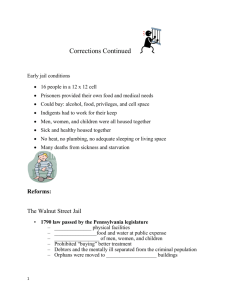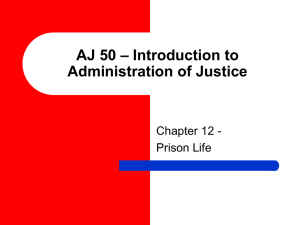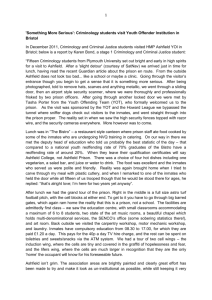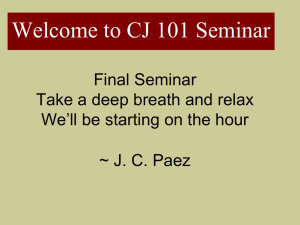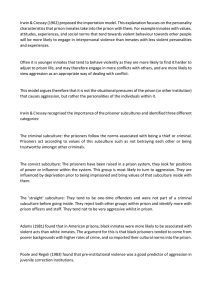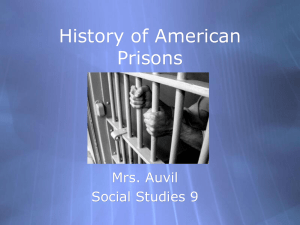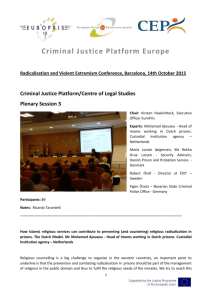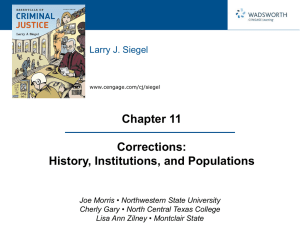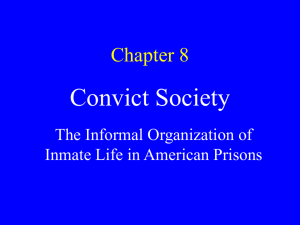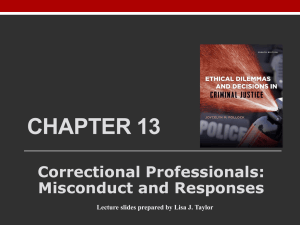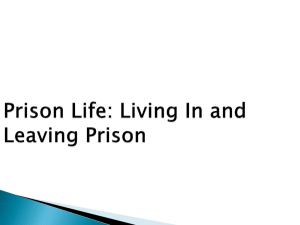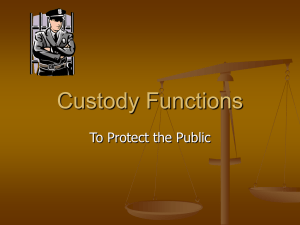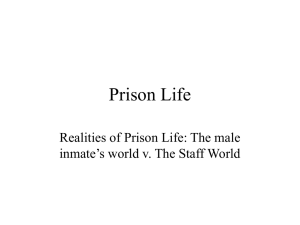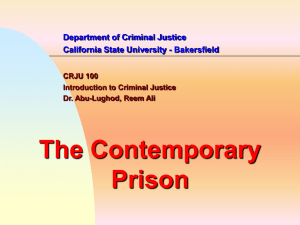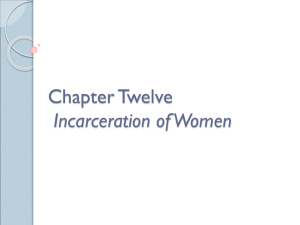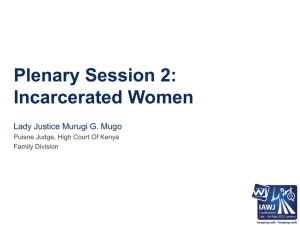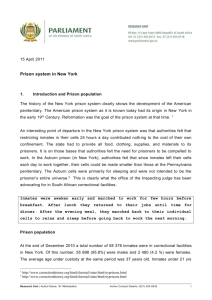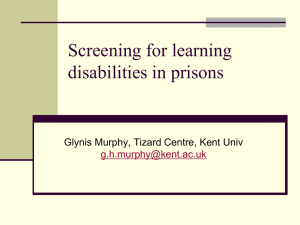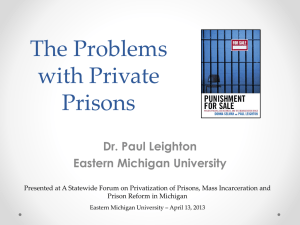Cruel and Unusual Punishment
advertisement
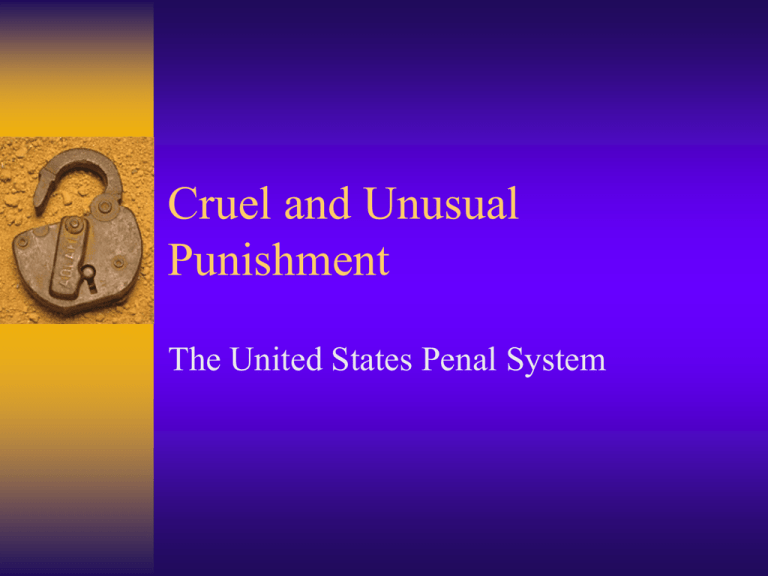
Cruel and Unusual Punishment The United States Penal System "Those of us on the outside do not like to think of wardens and guards as our surrogate, yet they are, and they are intimately locked in a deadly embrace with their human captives behind the prison walls, by extension, so are we." - Jessica Mitford, Kind and Usual Punishment: The Prison Business Pains of Imprisonment Loss of liberty, including separation from family members and friends. • The inability to maintain ties with the outside world produces enormous strains for inmates and their families. Deprivation of heterosexual relationships. Key to maintaining a sense of gender self. Loss of goods and services. The importance of our identity kit and our ability to express ourselves materially. Loss of autonomy and are denied the opportunity to make basic decisions affecting their lives. Loss of security. Inmates suffer from psychological, economic, social, and physical victimization during the terms of their confinement. Prisonization: American Style With the country's prisons and jails holding some two million adults--roughly one in every 140 persons--the rate of incarceration in the United States is about 727 prisoners per 100,000 residents.( No other country in the world is known to incarcerate as many people, and only a small handful of countries have anything approaching a similar rate of incarceration. Prison Population increased almost than 400% since 1980 in the United States. With less than 5 percent of the world's population, the United States holds 25 percent of the globe's prisoners. Factors that caused the increase Increase in the war on drugs. Increase in determinant sentencing – 3 strikes policy. Increase in poverty and inequality during the last 30 years in the U.S. Change in prison policy from rehabilitation to punishment. Victims Rights movement and the legitimation of retribution. Prison Conditions Overcrowding is a continual problem. Estimates are that most state prisons are at least 15 to 25% overcapacity. Due to public reluctance to spend any more than necessary to warehouse the criminal population, inmates generally have scant work, training, educational, treatment or counseling opportunities. Prison Population Males are more than 90 percent of all prisoners. More than 60% of the prison population is an ethnic minority (44% Black, 15% Hispanic, 2% Asian or Native American). Social class –poor, unskilled/educated, and lower income. 60%+ of the population are charged with drug offenses. The majority of prisoners are between eighteen and forty years old, trend toward longer sentences and more restrictive parole policies has increased the number of elderly inmates. There has been a notable increase over the past decade in the numbers of juveniles held in adult Violence in Prisons Inter-prisoner violence, extortion, harassment, and other abuse is even more common. Estimated that as many as 70 percent of inmates are assaulted by other inmates each year. In 1998, seventy-nine inmates were killed. Prison rape – estimates are from 7 to 15% of inmates according to studies in the 1980s. Human Rights Watch 2001 estimate up to 600,000 per year. Rarely is their prosecution for inter-prisoner violence. Guard violence is also a significant problem. Ethnic conflict within prisons Racial and ethnic antagonisms are another important contributing factor to prison violence and abuse. Race and Ethnicity is the great divide in prison. The level of racial antagonism appears to vary from jurisdiction to jurisdiction, with prisons in many Southern states being particularly tense. Ethnic gangs exist in every prison system and every large jail, Mexican Mafia, Black Gangster Disciples, Aryan Circle, White Knights, Latin Kings, etc. Cost of High Prisonization Rate Nearly $40 billion annually is spent on prisons and jails, making corrections one of the largest single items on many states' budgets, above their spending on higher education or child care. Increase in privatization to reduce costs. Appears to be increased problems of rioting and abuse in private prisons and not particularly cost effective. Super-maximum security, or "super-max," are one of the fastest-growing types of prison being built in America. 60 super-max facilities in 36 states holding approximately 20,000, 2% of the prison population. UW anthropologist Lorna Rhodes believes the actual number is more likely between 40,000 and 45,000 and estimates that between 15 and 25 percent of them are mentally ill. First one opened in 1963. Characteristics of Supermax Prisons Typically, inmates are confined in 8 x 10 foot cells for 23 hours a day in enforced idleness. The cells are windowless and have solid doors, so that the inmate cannot see or hear anything going on outside the cell. Inmates are "cell fed" -- their meals are delivered through slots in the cell doors, with no verbal or visual contact with the guards delivering the meals. No furniture or other amenities are allowed beyond the concrete and steel furniture in the cell - no television, no radio, no tobacco. There is always a physical barrier between the inmate and other human beings. Inmates in Super Max units are allowed one hour a day of solitary "recreation" in a concrete enclosure, their movements monitored by video cameras. Inmates are within close proximity of staff only when they are being visually searched as they stand naked before a control booth window before their one hour of "recreation." Typically, they remain shackled in front of their families during non-contact visits conducted behind clear partitions. Criticisms of Super Max units fall into five general areas. Potential for physical abuse by guards. Excessive confinement periods. Broad Assignment criteria. Treatment of Mentally Ill Inmates. Effect Upon Release. Long Term Effects – destruction of the inmate’s ties to society. Inmates in isolation retreat further and further into themselves. They start to discourage the few visitors they have because they become increasingly uncomfortable around people. Men in long-term isolation are more likely to see their marriages break up and their relationships with their children wither. By the time they are released, they have little prospect for adjusting to society and nobody left to help them. Long term effect of High Prisonization Rates. Opportunity costs. Underdevelopment of bridging programs. Increase in number of population marginal to society. Increase in poverty and inequality. Cycle of Violence. Increased dependence on repression and social control.

